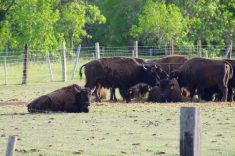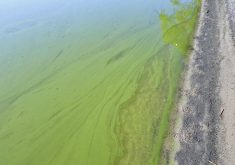Conservation districts in Manitoba won’t exactly be swimming in cash after last week’s announcement of $750,000 out of the federal-provincial Growing Forward 2 pot for water management projects on farms.
In fact, we wondered whether there wasn’t a zero or two missing after all the research that’s come out lately about the need for a better land and water interface in this province. The program dubbed Ecological Goods and Services seems even more miserly considering Manitoba’s conservation districts had $600,000 shaved from their revenue in the most recent provincial budget.
Read Also

Canada’s Grocery Code of Conduct just window dressing
The voluntary nature of Canada’s Grocery Code of Conduct robs it of effectiveness and won’t result in the food system accountability that’s needed.
But it’s no mistake. That’s all there is folks, and how much is there for next year will depend on how much uptake there is for this year’s. But don’t write it off.
Our advice is, call up your conservation district today and get your applications in early. Treat this program like a loss leader sale at your local grocers, where either you go in and stock up on stuff you were going to need anyway or you are enticed by the discounts to try something new or novel.
Keeping water on the land? What a concept. We’ve spent the better part of a century in this province taking the notion of getting water off the land to ridiculous extremes, which have had both short-term and long-term consequences.
This is not to suggest that all drainage must stop or that past policies were wrong. We wouldn’t have agriculture here without it. The reality now however, is that we need to build some resilience for water storage back into the system in order to handle the heavy rainfall events we can expect under climate change.
Swinging the pendulum back to a happy medium between allowing agriculture to prosper and maintaining a healthy environmental balance starts first with a change in attitude. Until that happens, it doesn’t matter how much money governments throw at the issue.
Water-retention structures, wetland restoration, wetland construction, riparian enhancement, improvements to natural areas, grassed waterways, perennial cover for sensitive lands and shelterbelts don’t come cheap. But there is a growing body of evidence to suggest they are a worthwhile investment that pays dividends over time.
We know from the phenomenon of disappearing shelterbelts that having public money in the game is of little value unless other stakeholders have some equity at stake too, whether it’s sweat or skin in the game.
This EGS program has the potential to help change attitudes toward the land and water management. The money is going into local hands, conservation districts that are already in tune with local watersheds and where they can get the best value from available resources.
For farmers, it offers an opportunity to test the waters, so to speak, and see for themselves whether some of these Best Management Practices (BMPs) add value by way of lowering costs through better risk management or direct returns.
Few people in Manitoba’s agricultural industry were as well known as Cam Brown, who passed away suddenly last week at age 84. As will more than a few readers, I knew Cam as a former colleague in one of the stops in his long career, which started with selling vegetables from his family’s farm on the outskirts of Winnipeg. After graduating from the University of Manitoba with a master’s degree in swine nutrition in 1952, he went on to a career as an ag rep in Manitoba and Alberta, a field supervisor with Manitoba Pool, director of research for the rapeseed association, director of market development for the wheat board and as a vice-president and later director of Feed-Rite.
Cam “retired” several years ago, but you would hardly have known it. There was hardly an industry event where he was not seen engaged in a lively conversation. Cam was especially devoted to the profession of agrology and was a tireless supporter and fundraiser for the faculty of agriculture, playing a leading role in the campaign to raise capital for the new agriculture building on campus. In 2010 he was inducted into the Manitoba Agricultural Hall of Fame, and just a few weeks ago it was a pleasure to watch Cam personally make the first presentation of a scholarship in his name. He was particularly proud that the scholarship was for work outside the province or outside the country, as he had strong views on the importance of a broad perspective on the issues in the industry.
Indeed, Cam had many strong views, and one of his best attributes was his ability to express them yet still remain on good terms with those on the other side of the issue. We’ll miss Cam’s example of good reason and good humour, and join with many readers in offering condolences to his wife Maxine, sons Brock and Martin and their families, and his many friends.















